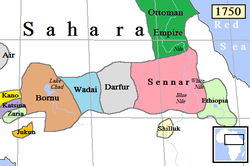სენარის სასულთნო
ფუნჯების სენარის სასულთნო (ან სინარი), ტრადიციულად ასევე ცისფერი სასულთნო (არაბ. السلطنة الزرقاء; ას-სალტანა აზ-ზარქა) — სასულთნო დღევანდელი სუდანის ჩრდილოეთ ნაწილში. სასულთნო დააარსეს ფუნჯებმა (ნუბიური ტომის). სასულთნოს დასახელება მომდინარეობს მისი დედაქალაქის სინარის სახელიდან. სასულთნო არსებობდა 1504–1821 წლებში.
| სენარის სასულთნო السلطنة الزرقاء (არაბული ენა) ას-სალტანა აზ-ზარქა სასულთნოების და ტომების კონფედერაცია სენატრის პროტექტორატის ქვეშ. | ||||
| ||||
|---|---|---|---|---|
 სენარის სასულთნო (ვარდისფრად) და მეზობელი ქვეყნები 1750 წელს. | ||||
| დედაქალაქი | სენარი | |||
| ენა | არაბული.[1] | |||
| ფულის ერთეული | ბარტერი.[2] | |||
| მოსახლეობა | 5,156,000 | |||
| სულთანი | ||||
| - | ამარა დუნქასი (პირველი) | |||
| სულთანი | ||||
| - | ბადი VII (ბოლო) | |||
| ადრეული თანამედროვე პერიოდი | ||||
| ისტორია | ||||
| - დაარსება | 1504 | |||
| - მუჰამედ ალის ჯარის მიერ დაპყრობა. | 14 ივნისი 1821 | |||
ლიტერატურა
რედაქტირება- R.S. O'Fahey and J.L Spaulding: Kingdoms of the Sudan Studies of African History Vol. 9, Methuen, London 1974, ISBN 0-416-77450-4
- Arthur E. Robinson, "Some Notes on the Regalia of the Fung Sultans of Sennar", Journal of the Royal African Society, 30 (1931), pp. 361–376
სქოლიო
რედაქტირება- ↑ McHugh, Neil (1994). Holymen of the Blue Nile: The Making of an Arab-Islamic Community in the Nilotic Sudan, 1500–1850, Series in Islam and Society in Africa. Evanston, IL: Northwestern University Press, გვ. 9. ISBN 978-0-8101-1069-4. „The spread of Arabic flowed not only from the dispersion of Arabs but from the unification of the Nile by a government, the Funj sultanate, that utilized Arabic as an official means of communication, and from the use of Arabic as a trade language.“
- ↑ Anderson, Julie R. (2008). „A Mamluk Coin from Kulubnarti, Sudan“ (PDF). British Museum Studies in Ancient Egypt and Sudan (10): p. 68. ციტირების თარიღი: 12 August 2010. ციტატა: „Much further to the south, the Funj Sultanate based in Sennar (1504/5–1820), did not mint coins and the markets did not normally use coinage as a form of exchange. Foreign coins themselves were commodities and frequently kept for jewellery. Units of items such as gold, grain, iron, cloth and salt had specific values and were used for trade, particularly on a national level.“CS1-ის მხარდაჭერა: დამატებითი ტექსტი (link)